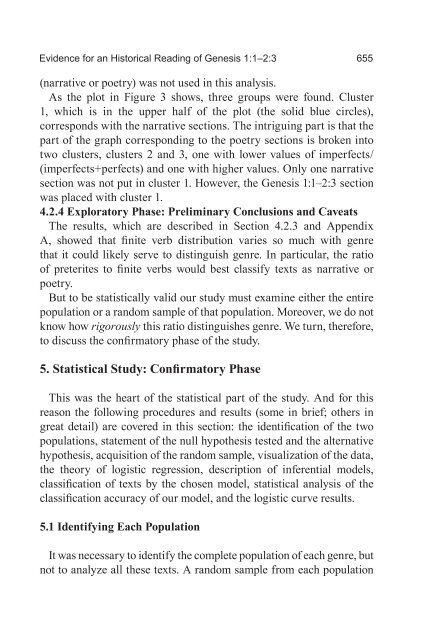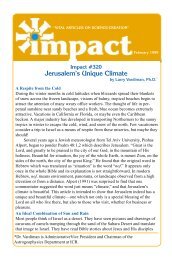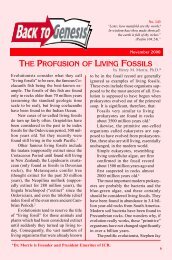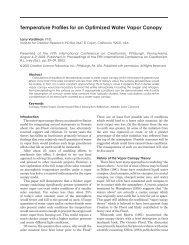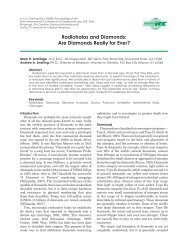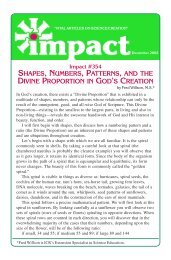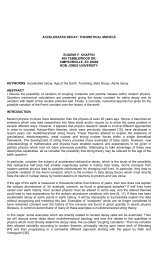Statistical Determination of Genre in Biblical Hebrew - Institute for ...
Statistical Determination of Genre in Biblical Hebrew - Institute for ...
Statistical Determination of Genre in Biblical Hebrew - Institute for ...
You also want an ePaper? Increase the reach of your titles
YUMPU automatically turns print PDFs into web optimized ePapers that Google loves.
Evidence <strong>for</strong> an Historical Read<strong>in</strong>g <strong>of</strong> Genesis 1:1–2:3 655(narrative or poetry) was not used <strong>in</strong> this analysis.As the plot <strong>in</strong> Figure 3 shows, three groups were found. Cluster1, which is <strong>in</strong> the upper half <strong>of</strong> the plot (the solid blue circles),corresponds with the narrative sections. The <strong>in</strong>trigu<strong>in</strong>g part is that thepart <strong>of</strong> the graph correspond<strong>in</strong>g to the poetry sections is broken <strong>in</strong>totwo clusters, clusters 2 and 3, one with lower values <strong>of</strong> imperfects/(imperfects+perfects) and one with higher values. Only one narrativesection was not put <strong>in</strong> cluster 1. However, the Genesis 1:1–2:3 sectionwas placed with cluster 1.4.2.4 Exploratory Phase: Prelim<strong>in</strong>ary Conclusions and CaveatsThe results, which are described <strong>in</strong> Section 4.2.3 and AppendixA, showed that f<strong>in</strong>ite verb distribution varies so much with genrethat it could likely serve to dist<strong>in</strong>guish genre. In particular, the ratio<strong>of</strong> preterites to f<strong>in</strong>ite verbs would best classify texts as narrative orpoetry.But to be statistically valid our study must exam<strong>in</strong>e either the entirepopulation or a random sample <strong>of</strong> that population. Moreover, we do notknow how rigorously this ratio dist<strong>in</strong>guishes genre. We turn, there<strong>for</strong>e,to discuss the confirmatory phase <strong>of</strong> the study.5. <strong>Statistical</strong> Study: Confirmatory PhaseThis was the heart <strong>of</strong> the statistical part <strong>of</strong> the study. And <strong>for</strong> thisreason the follow<strong>in</strong>g procedures and results (some <strong>in</strong> brief; others <strong>in</strong>great detail) are covered <strong>in</strong> this section: the identification <strong>of</strong> the twopopulations, statement <strong>of</strong> the null hypothesis tested and the alternativehypothesis, acquisition <strong>of</strong> the random sample, visualization <strong>of</strong> the data,the theory <strong>of</strong> logistic regression, description <strong>of</strong> <strong>in</strong>ferential models,classification <strong>of</strong> texts by the chosen model, statistical analysis <strong>of</strong> theclassification accuracy <strong>of</strong> our model, and the logistic curve results.5.1 Identify<strong>in</strong>g Each PopulationIt was necessary to identify the complete population <strong>of</strong> each genre, butnot to analyze all these texts. A random sample from each population


